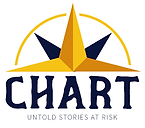

About CHART
The Coastal Heritage at Risk Taskforce (CHART) is a many armed decolonial taskforce focused on the untold stories of Black, Indigenous, and LatinX heritage along the southeast coast of the U.S. to the Caribbean. CHART’s aim is to decolonize cultural revitalization, preservation, resilience, and storytelling efforts at biocultural heritage sites at risk from climate impacts. Our multiple projects follow the paths of Black resilience, African liberation, and Indigenous survivance across Florida to the Caribbean, many ending on the Saltwater Underground Railroad (SUR).
CHART first formed in 2012 as rising sea levels and storm surges put tens of thousands of heritage sites at risk across Florida. As an international taskforce CHART has partnered with various community-based cultural heritage orgs, museums, Indigenous-led environmental NGOs, heritage sites, parks, and coastal communities. We are environmental scientists, archaeologists, teachers, anthropologists, engineers, media designers, biogeographers, and decolonial social scientists.
Our Mission
-
To support cultural revitalization of coastal communities and all forms of Indigenous sovereignty.
-
To aid in postcolonial reparations efforts related to climate justice.
-
To publish, tell, and support decolonial re-storying efforts for education and climate justice.
-
To center communities' priorities and oral histories.
-
To promote decolonial environmental conservation efforts.
-
To put untold stories on national maps.



